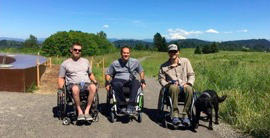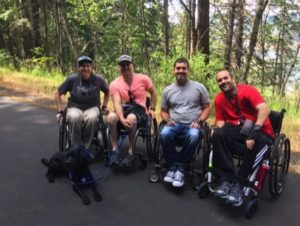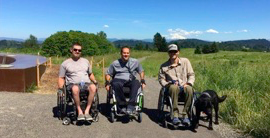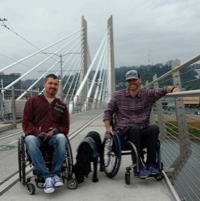
Out and About with the Cripple Triple Threat
I recently joined a wheelchair gang called The Cripple Triple Threat. It’s the only one I know of in Portland—maybe even in all of Oregon. Dave, Josiah, and I formed the group last summer while wheelchair hiking. That’s how our friendship began. We try not to take up the whole trail. As we roll along, we joke about life in a wheelchair and how intimidating we must look. Most of the time, we laugh about people thinking we escaped from a hospital and are on the run. I’m sure we’re quite a sight.
With spring here, we plan to hit the trails around Portland every chance we get. Last year, we had a few favorites. One was the downtown bridge loop. It connects the Steel, Morrison, Hawthorne, and Tillikum Crossing bridges via the Eastbank Esplanade and the Waterfront Trail. In the Gorge, we found the Mosier Tunnel Trail east of Hood River. The old highway there is now a safe, scenic, pedestrian-only path. For a real challenge, we also summited Powell Butte.This year, we’re aiming to try the Banks-Vernonia State Trail. It’s a paved, hilly route built on an old railroad line.
Oregon is full of amazing hiking spots, and Oregonians love to explore them. After a long, rainy winter, we’re ready to soak in nature’s beauty. Who doesn’t melt when the first warm rays of sun touch your face? That first dose of vitamin D feels like it wakes up your sense of adventure. What better way to celebrate spring than by hitting the trails? Thanks to AccessTrails.org, it’s easier than ever. The site offers maps, photos, videos, and detailed info about trail accessibility around the Portland metro area.
But for many people, especially those with disabilities, hitting the trails for exercise or any reason, is difficult. In Oregon, according to a state-wide survey a whopping 32% of individuals who reported having a disability in 2015 had not exercised for 30 minutes in the last 30 days, as compared to only 12% of those who reported not having a disability. This is because it’s more difficult for people with disabilities than without to get exercise!
Hiking—or rolling—offers many proven health benefits. The Centers for Disease Control and Prevention states that physically active people live longer. They also face lower risks of heart disease, stroke, type 2 diabetes, depression, and some cancers. The National Center on Health, Physical Activity, and Disability (NCHPAD) adds that exercise releases endorphins, which help reduce stress. Exercising with others brings even more benefits. It helps build and strengthen friendships, which can improve emotional health and create lasting support beyond the trail. Together, these effects boost overall quality of life. They increase confidence, joy, and self-image. So while hiking is fun, it’s also a powerful tool for physical and mental well-being. Hitting the trail with friends isn’t just a good time—it’s one of the best things you can do for your health.

The Cripple Triple Threat – three guys in wheelchairs who enjoy nature and each other’s humor – is an example of how friendships and hiking can improve your quality of life. As the weather turns nicer, check out AccessTrails.org to find a trail that is suitable for you and invite a friend to explore the trails around Portland.
Resources:
National Center on Health, Physical Activity, and Disability (www.nchpad.org)
Center for Disease Control and Prevention (www.cdc.gov)




